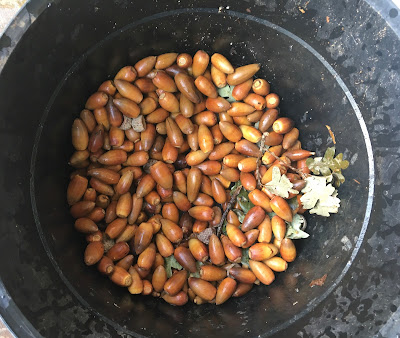
Tree planting set for Saturday at Stone Lakes wildlife refuge

|
|
It doesn’t take long for acorns to grow into oak trees. Oak seedlings
will be planted Saturday at Stone Lakes National Wildlife Refuge. (Photo: Kathy Morrison) |
Get more exercise. Help the environment. Volunteer.
Do those actions sound like your new year’s resolutions? Then, you’re in luck. On Saturday morning , the Sacramento Tree Foundation is hosting a tree planting event that covers all three.
From 8:45 a.m. to 1 p.m. Saturday, Jan. 8 , SacTree volunteers will plant up to 150 native tree seedlings at Stone Lakes National Wildlife Refuge in Sacramento County. Registration is free but limited; volunteers should sign up in advance to get directions and save their spots.
“Help us reforest the riparian oak woodlands of the Stone Lakes National Wildlife Refuge,” says the foundation. “In partnership with refuge staff and the County of Sacramento, we will be planting up to 150 native tree seedlings along the upper reaches of Snodgrass Slough. Reforestation is underway at this location to secure and improve the wildlife habitat protected and stewarded by our only local National Wildlife Refuge. This event will be a great opportunity to learn more about locally native trees, wildlife habitat, and to see some of the migratory waterfowl that visit Stone Lakes in the winter.”
This tree planting event is no walk in the park. Volunteers will need to hike 1 mile across muddy cow pastures to get to the planting sites, then 1 mile back to the parking lot.
:This project will require significant physical exertion and may not be appropriate for all participants,” warns SacTree. “ You will get wet and muddy at this event. Rubber boots and rugged outdoor-wear are highly recommended.”
Volunteers must commit to the full four-plus hours, too.
“All attendees must meet the group at check-in and be able to stay for the entire event,” says SacTree. “ Late arrivals and early departures cannot be accommodated due to access requirements. We will be working in an area of the refuge that is not open to the public and travel to and from the site must be supervised by Sacramento Tree Foundation staff.”
Bring your muscle but leave tools at home.
“We provide all the necessary tools and supplies to care for trees,” SacTree says. “Participants will receive a short, hands-on training on site. After learning the tools and techniques, participants will split up into groups and begin planting trees on residential properties.”
Once registered, participants will get directions to the Stone Lakes parking lot and more details.
Sign up here: https://sactree.org/event/native-tree-planting-at-stone-lakes-national-wildlife-refuge/
For more information: www.sactree.com .
Comments
0 comments have been posted.Sacramento Digs Gardening to your inbox.
Sites We Like
Garden Checklist for week of April 21
This week there’s plenty to keep gardeners busy. With no rain in the immediate forecast, remember to irrigate any new transplants.
* Weed, weed, weed! Get them before they flower and go to seed.
* April is the last chance to plant citrus trees such as dwarf orange, lemon and kumquat. These trees also look good in landscaping and provide fresh fruit in winter.
* Smell orange blossoms? Feed citrus trees with a low dose of balanced fertilizer (such as 10-10-10) during bloom to help set fruit. Keep an eye out for ants.
* Apply slow-release fertilizer to the lawn.
* Thoroughly clean debris from the bottom of outdoor ponds or fountains.
* Spring brings a flush of rapid growth, and that means your garden is really hungry. Feed shrubs and trees with a slow-release fertilizer. Or mulch with a 1-inch layer of compost.
* Azaleas and camellias looking a little yellow? If leaves are turning yellow between the veins, give them a boost with chelated iron.
* Trim dead flowers but not leaves from spring-flowering bulbs such as daffodils and tulips. Those leaves gather energy to create next year's flowers. Also, give the bulbs a fertilizer boost after bloom.
* Pinch chrysanthemums back to 12 inches for fall flowers. Cut old stems to the ground.
* Mulch around plants to conserve moisture and control weeds.
* From seed, plant beans, beets, cantaloupes, carrots, corn, cucumbers, melons, radishes and squash.
* Plant onion sets.
* In the flower garden, plant seeds for asters, cosmos, celosia, marigolds, salvia, sunflowers and zinnias.
* Transplant petunias, zinnias, geraniums and other summer bloomers.
* Plant perennials and dahlia tubers for summer bloom.
* Mid to late April is about the last chance to plant summer bulbs, such as gladiolus and tuberous begonias.
* Transplant lettuce seedlings. Choose varieties that mature quickly such as loose leaf.